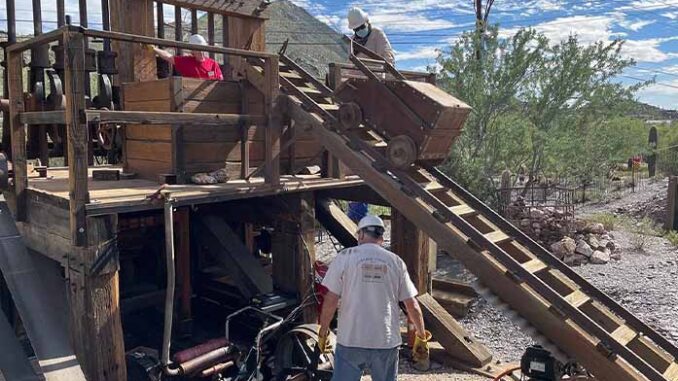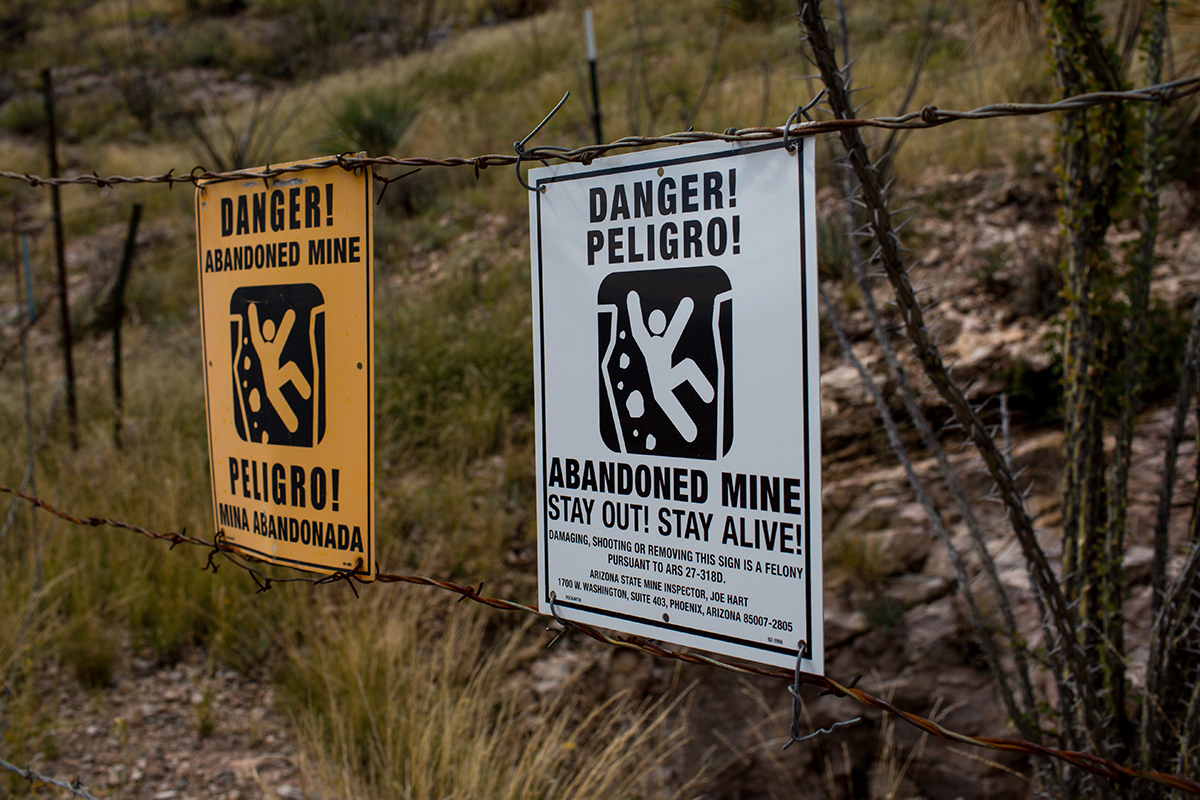
CAVE CREEK – Ten steel rods, each weighing 1,000 pounds, pulverize gold-bearing rocks into sand, releasing the precious metal from the ore, which is then further refined with mercury to extract every flake.
This is a stamp mill, a 19th-century invention that saved miners from extracting precious minerals by hand, which took far more time and effort. The stamping process – re-created at the Cave Creek Museum’s Arizona Gold Mining Experience – was used at the turn of the 20th century across much of Arizona, which has a storied history of mining.
The museum hosts monthly demonstrations of the Golden Reef Stamp Mill & Tramway to show what it was like for miners in the Cave Creek Mining District, where the first claims were made in the 1870s. The demonstrations will continue through May on the second Saturday of each month.
Because stamp mills require water and mines typically were on mountaintops without water access, miners built tramways to transfer ore in buckets from mines to the stamp mill at a lower elevation.
The Golden Reef Stamp Mill was built in 1910 on Continental Mountain northeast of town. It was donated to the museum in 2008, and staff and volunteers toiled five years to restore it. The tramway tower is a replica of the original, built in 1913, which transferred ore 2,000 feet down the mountain. At the museum, the shortened tramway hauls ore from the crusher up to the stamps.

When the donated mill arrived, it was just pieces of metal on the ground and three pieces of wood, said Evelyn Johnson, the Cave Creek Museum’s interim executive director.
The mill is the only 10-stamp mill in Arizona that’s still in its original mining district.
“There’s all this equipment and all these parts of the old mining experience that we want people to understand what it was like to be a miner, what their life was like, how hard it was,” said Greg Barnhardt, a demonstrator for the Arizona Gold Mining Experience.
To get 1 ounce of gold, the miners had to process 1 ton of ore, said Charlie Connell, who also demonstrates the stamp mill. It was long, hard work to earn $20, which is what an ounce of gold sold for in the early 1900s, he said.
A stamp mill pounds ore, as opposed to grinding it.

The whole idea here is to start with big rocks and end up with sand, and the stamp mill drastically sped up this process, Barnhardt said.
After the ore goes through the crusher, it’s brought up the tramway, where it’s pulverized by half-ton metal rods that are synchronized to slide up and down in a frame. The pulverized ore goes onto the sluice tables, where debris is washed from the heavier pieces of gold. Some ore goes to the shaker, where mercury binds to minute flakes of gold in what’s known as an amalgam; the mercury later is vaporized to leave nearly pure gold.
“If you have a stamp mill, you want to run it 24 hours a day, so you’d run two shifts,” Barnhardt said. “The Golden Reef Mine had 20 miners, where 10 would work one eight-hour shift, and the other 10 would work the other shift.”
A stamp mill cost about $20,000 in 1910, Barnhardt said. Barnhardt said the Cave Creek miners raised the money they needed, and hauled all the equipment up the mountainside.
Before the stamp mill was introduced in 1829, miners pulverized ore by hand using a circular pit. Mules dragged the ore around the pit for two to three days and pulverized the ore, Barnhardt said.
“So then investors started looking at this and said, ‘Hey, if we process more ore, we could get more money, so how do we do that? Well, we need more equipment, we need more men, we need some automation here,’” Barnhardt said.
Investors thought the Cave Creek district would be highly lucrative because large amounts of gold and other precious metals had been found on the surface, Barnhardt said, but shaft mining revealed that wasn’t the case.
“They only got a quarter of a million dollars of gold right here (in Cave Creek) in 50 years, and the investment alone was over $2 million dollars,” he said. “So from a return on investment, not good.”
The museum plans to add a mining shaft and a dynamite detonation to the Arizona Gold Mining Experience. It will be a hands-on experience for a fee.

